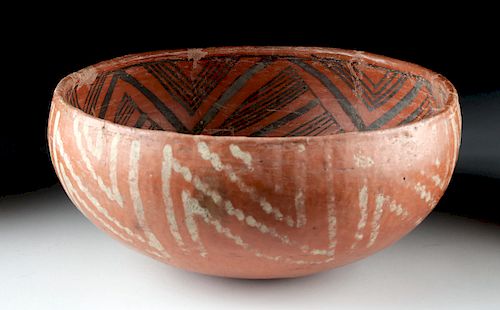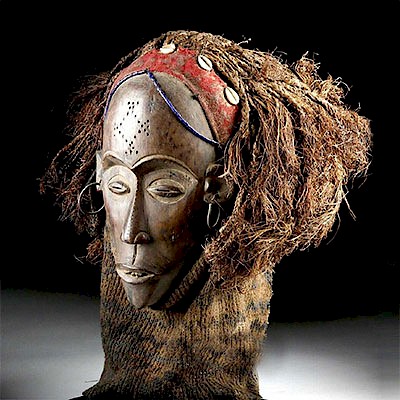Anasazi St. John's Polychrome Bowl
Lot 97f
About Seller
Artemis Gallery
686 S Taylor Ave, Ste 106
Louisville, CO 80027
United States
Selling antiquities, ancient and ethnographic art online since 1993, Artemis Gallery specializes in Classical Antiquities (Egyptian, Greek, Roman, Near Eastern), Asian, Pre-Columbian, African / Tribal / Oceanographic art. Our extensive inventory includes pottery, stone, metal, wood, glass and textil...Read more
Estimate:
$700 - $1,000
Absentee vs Live bid
Two ways to bid:
- Leave a max absentee bid and the platform will bid on your behalf up to your maximum bid during the live auction.
- Bid live during the auction and your bids will be submitted real-time to the auctioneer.
Bid Increments
| Price | Bid Increment |
|---|---|
| $0 | $25 |
| $300 | $50 |
| $1,000 | $100 |
| $2,000 | $250 |
| $5,000 | $500 |
| $10,000 | $1,000 |
| $20,000 | $2,500 |
| $50,000 | $5,000 |
| $100,000 | $10,000 |
| $200,000 | $20,000 |
About Auction
By Artemis Gallery
Apr 4, 2019
Set Reminder
2019-04-04 10:00:00
2019-04-04 10:00:00
America/New_York
Bidsquare
Bidsquare : Ancient / Ethnographic From Around The World
https://www.bidsquare.com/auctions/artemis-gallery/ancient-ethnographic-from-around-the-world-4003
Ancient art from Egypt, Greece, Italy and the Near East, as well as Asian, Pre-Columbian, Native American, African / Tribal / Oceanic, Spanish Colonial, Russian Icons, Fine art, much more! All categories, all price ranges... all legally acquired and guaranteed to be as described or your money back Artemis Gallery info@artemisgallery.com
Ancient art from Egypt, Greece, Italy and the Near East, as well as Asian, Pre-Columbian, Native American, African / Tribal / Oceanic, Spanish Colonial, Russian Icons, Fine art, much more! All categories, all price ranges... all legally acquired and guaranteed to be as described or your money back Artemis Gallery info@artemisgallery.com
- Lot Description
Southwestern USA, east central Arizona/west southern New Mexico, Ancestral Puebloan (Anasazi), ca. 1175 to 1300 CE. A beautiful bowl with bright colors that pop, created by Anasazi artisans of St. Johns - the first Anasazi potters to make polychrome pottery during the prehistoric period. Prior to this, pottery was either black-on-white or black-on-red. Here we see black-on-red interior, but added white-on-red on the exterior walls - the third color making for a polychrome designation. On the interior is a repeated, intricate pattern of interlocking triangles in black over a red background, with the tondo left red, so that the overall pattern looks like a sunburst. On the exterior is a stepped pattern of white on red. Size: 9" W x 4.2" H (22.9 cm x 10.7 cm)
The Mogollon people created pottery from iron-rich volcanic clays using the coil-and-scrape technique. The type is known primarily from the Pinedale Ruin, a settlement of approximately 200 rooms located near modern-day Show Low, Arizona, that was sadly lost to bulldozers in the 1970s. The people who lived at Pinedale would have been at the edges of the cultural sphere governed by Chaco Canyon, and by the time they created this bowl, lived a sedentary agricultural lifestyle. A bowl like this one may have held ground corn.
Provenance: private Colorado, USA collection; ex-German collection
All items legal to buy/sell under U.S. Statute covering cultural patrimony Code 2600, CHAPTER 14, and are guaranteed to be as described or your money back.
A Certificate of Authenticity will accompany all winning bids.
We ship worldwide and handle all shipping in-house for your convenience.
#144739Repaired from approximately a dozen pieces. Repairs are generally unobtrusive. All pigment is original and in nice condition.Condition
- Shipping Info
-
All shipping is handled in-house for your convenience. Your invoice from Artemis Gallery will include shipping calculation instructions. If in doubt, please inquire BEFORE bidding for estimated shipping costs for individual items.
-
- Buyer's Premium



 EUR
EUR CAD
CAD AUD
AUD GBP
GBP MXN
MXN HKD
HKD CNY
CNY MYR
MYR SEK
SEK SGD
SGD CHF
CHF THB
THB
















